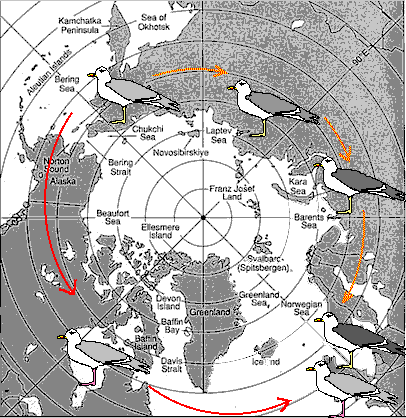|
Your "story" may be different from mine but here I have
assumed that the Vega Gull started it all.
I imagine that the Vega Gull hopped over to North America creating
a colony of Herring Gulls which developed the mutation that causes
their legs to be pink.
These American Herring Gulls colonised
all of North America and eventually made the big leap across the
Atlantic to colonise the UK. Meanwhile, the Vega Gulls from Siberia
had been moving westward across Russia and developing dark backs
as they colonised the new lands, giving rise to Birula's Gulls
and Heuglin's Gulls. By the time they colonised Europe their backs
were so dark that they had become the Back-backed Gulls.
In the UK the Black-backed Gulls met the Herring Gulls and we
have our two species.
| 
|
Which "story" is correct? Well, with this data it is
hard to say. It might help to take careful measurements of all
the different gulls involved in the ring and try to figure out
the most likely story. Certainly modern techniques in biochemistry
and genetics would provide useful data. Regardless of the actual
events, ring speciation has occurred with these gulls.
We see ring species throughout the world with other animals and
even among plants. The ring may be formed by any physical barrier
that inhibits individuals from getting together for mating. The
ring acts as a physical barrier to their reproduction. These barriers
may be oceans (as in the example), mountains, deserts or even
lakes. Once the two ends of the ring met the two forms are so
different that they are different species and their reproductive
isolation continues due to non-physical barriers such as behavioural
differences.
I hope the examples in this lesson have convinced you that we
can observe evolution on a small scale.
- You've seen examples of how artificial selection has been
used over a long period of time to domesticate dogs, crops,
etc. in a purposeful way.
- You've seen evidence of selection quickly influencing the
evolution of colouring in Peppered Moths and pesticide resistance
in insects all by accident.
- I've described carefully controlled experiments of evolution
in the laboratory in which rats were artificially selected for
different degrees of tooth decay.
All of these show how selection can influence the types of organisms
in subsequent generations and thus give rise to different populations.
I've also shown you some examples of true speciation occurring.
- Polyploidy in plants is a fine example of how laboratory work
in evolution can be used to better understand speciation in the
wild.
- The formation of ring species illustrates how one species
can diverge into two species, given enough time and isolation.
You may be wondering if these processes can operate over a longer
scale and give rise to greater diversity. We answer that in our
next lesson as I show you more evidence for evolution by Natural
Selection.
You have completed Lesson 2 and now is a good time to take a break and review your notes.
This work was created by Dr Jamie Love  and
and  licensed under a Creative Commons Attribution-ShareAlike 4.0 International License.
licensed under a Creative Commons Attribution-ShareAlike 4.0 International License.
If you like, you can return to the Home Page.

 and
and  licensed under a Creative Commons Attribution-ShareAlike 4.0 International License.
licensed under a Creative Commons Attribution-ShareAlike 4.0 International License.